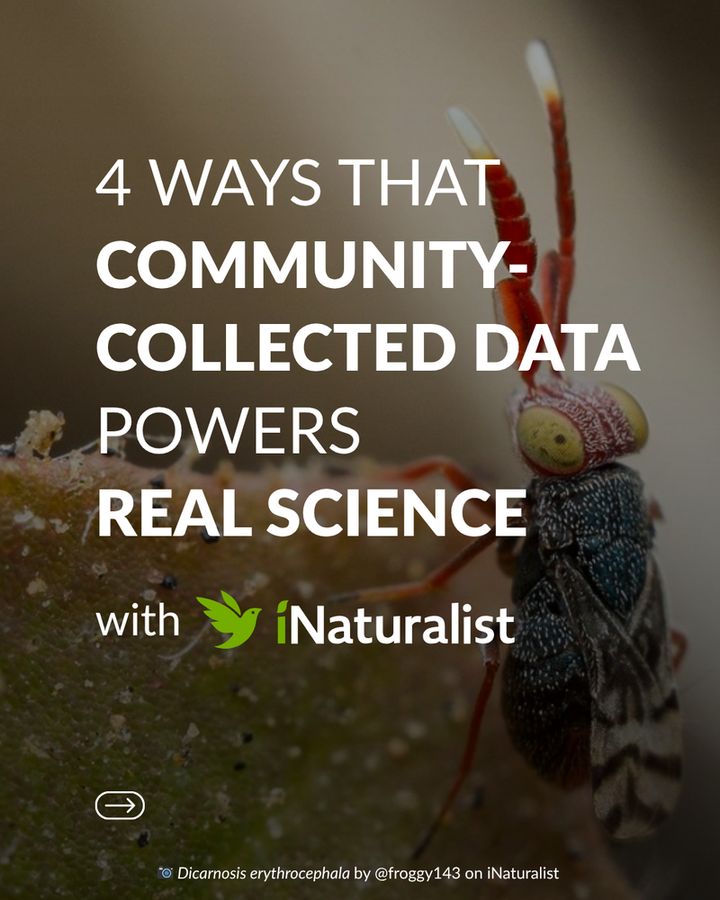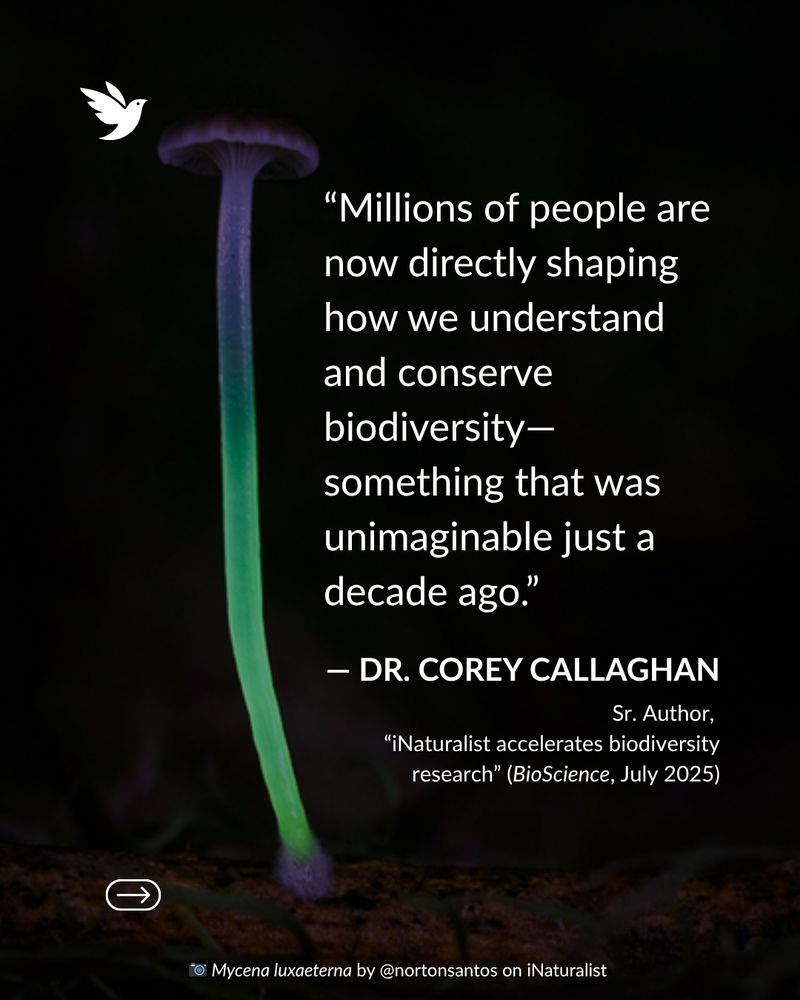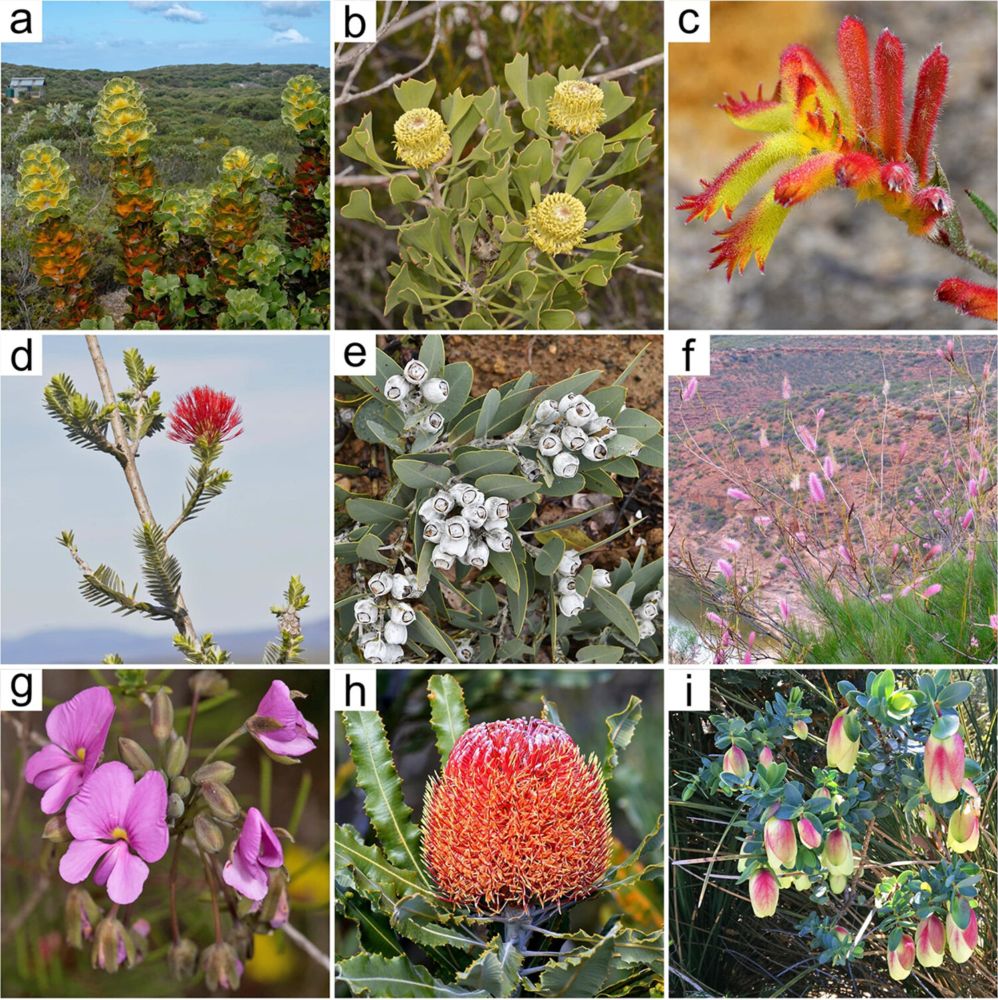"who knows?"
--> and yet you + others continue to unhelpfully speculate. I'm unsure you understand what 'pivot' means if that's how you interpret a proposed demo which may never progress further after testing
also fyi using iNat data in research ≠ 'working with them'
have a great day
29.07.2025 09:37 — 👍 0 🔁 0 💬 0 📌 0
Check out our new paper exploring the incredible uses of @inaturalist.bsky.social data in biodiversity research!
29.07.2025 01:05 — 👍 21 🔁 3 💬 0 📌 1
"pivoting to generative AI" is a strange and very misleading characterisation of the planned demo that does not accurately described the currently intended tool whatsoever
29.07.2025 01:04 — 👍 0 🔁 0 💬 0 📌 0


This new paper documents a tenfold increase in research papers using community-collected iNaturalist data over just five years: tr.ee/89Ot3I
According to the study, here are four key ways that iNaturalist data directly powers science 🧵⤵️
28.07.2025 16:37 — 👍 91 🔁 41 💬 2 📌 2
did you use the Shiny app, or the R package? The latter allows you to use infinitylists for anywhere in the world, the former only for select regions as a demo of the functionality
12.06.2025 02:17 — 👍 1 🔁 0 💬 1 📌 0
Don't know what you are looking for? 🔍 We made something ✨ #Shiny ✨ using biodiversity data from {galah} to create location taxon lists for naturalists 🦉🦋🍄🐌🌳
@thebeachcomber.bsky.social @willcornwell.bsky.social @hsauquet.bsky.social
11.06.2025 23:18 — 👍 13 🔁 6 💬 0 📌 0
humans make mistakes all the time when IDing stuff. Could be any number of reasons: it's a woodpecker, and it's olive-coloured, so that's what they typed (this is why there are so many black house ant misIDs). Or, there's a local species with the common name olive woodpecker as well
10.06.2025 23:18 — 👍 1 🔁 0 💬 1 📌 0
that first ID wasn't made by AI, and that species isn't one of the suggestions at all for that record when you query the AI. In fact, when you check it the top suggestion by the AI is the correct species ID
10.06.2025 22:52 — 👍 1 🔁 0 💬 1 📌 0
nice one Francesco! I've added both species to iNat for you ;)
19.05.2025 22:56 — 👍 1 🔁 0 💬 0 📌 0
A fun short paper we wrote about new plant species discovered and subsequently described thanks to @inaturalist.bsky.social records, with recommendations for optimising this process into the future!
17.05.2025 11:59 — 👍 21 🔁 7 💬 1 📌 0
Sydney Harbour Fishes
New field guide incoming: Sydney Harbour Fishes
2,500+ colour photographs
>700 species
>300 photographers
almost all images from Australasian Fishes (www.inaturalist.org/projects/aus...) on @inaturalist.bsky.social
May release, now accepting pre-orders at sydneyharbourfishes.company.site
03.04.2025 07:32 — 👍 3 🔁 1 💬 1 📌 0

Figure 6 from Mesaglio and Callaghan 2021. Conceptual figure showing the positive feedback loop as iNaturalist continues to grow in Australia. As more taxonomic experts join iNaturalist, more observations will increase the bioliteracy of the data, providing more data for ecological and conservation research questions in Australia.
We extensively discuss why accuracy was so high, but key is that many experts have already spent years sharing their knowledge on iNat. It's clear: consistent expert engagement with citizen science, and the learning by citizen scientists that results, drives high quality biodiversity datasets.
17.03.2025 04:42 — 👍 15 🔁 4 💬 0 📌 0

Figure 4 from Mesaglio et al. 2025. Assessment of identification accuracy after expert identification (ID) blitz. All illustrations by Thomas Mesaglio, from top to bottom: Caladenia flava R.Br. (Orchidaceae), Burchardia rosea Keighery (Colchicaceae), Lechenaultia biloba Lindl. (Goodeniaceae), Nematolepis phebalioides Turcz. (Rutaceae).
What did we find? Almost 11,000 records were reviewed by at least one expert during the event. Of the 7,000+ records from our dataset that were identified to species or finer, 92% of them were correctly identified. And if only considering the ~3,500 Research Grade records, these were 97% accurate.
17.03.2025 04:42 — 👍 5 🔁 1 💬 1 📌 0

Figure 1 from Mesaglio et al. 2025. Locations for the 2024 Western Australian iNaturalist plant identification blitz. Note that each area encompasses a larger zone centred on the national park itself. Photographs by Thomas Mesaglio.
We recruited over 50 taxonomists, botanists and other experts with knowledge of the Western Australian flora, and gave them three weeks to assess the ID accuracy of thousands of iNat records from three regions in WA as part of an 'expert ID blitz'.
17.03.2025 04:42 — 👍 3 🔁 1 💬 1 📌 0

Updates to Australian plant taxonomy
Keeping track of new taxonomic changes and species descriptions can be tough, so I've created a living spreadsheet to document recent taxonomic works relating to Australian plants, and provide an easy to access central resource. It will be updated every week or two
docs.google.com/spreadsheets...
25.12.2024 09:10 — 👍 5 🔁 1 💬 0 📌 0

Leichhardt's Grasshopper (Petasida ephippigera) on host plant Pityrodia jamesii in Kakadu National Park, Northern Territory.
Photographed one of my mega bucket list species on a recent trip to Kakadu NP, the amazing Leichhardt's Grasshopper (Petasida ephippigera). Found only across the Top End of the NT, this species is on the decline. I waited almost 5 years to see this grasshopper after failing to find one in March 2020
17.12.2024 00:12 — 👍 4 🔁 0 💬 0 📌 0
But discovery hasn't finished! Since we ran the numbers earlier this year, at least 50 new species (mostly introduced) have already been found for Royal, with a smaller handful for Yosemite. There's still lots to discover, so head out there with your camera and plant press!
02.12.2024 01:36 — 👍 3 🔁 0 💬 0 📌 0

Plant species newly recorded for Royal National Park (a-c) and Yosemite National Park (d-f) from Research Grade iNaturalist observations. a) Pleroma urvilleanum (Melastomataceae), introduced, photograph by Thomas Mesaglio, CC BY; b) Thelymitra improcera (Orchidaceae), native, photograph by Robert Humphries, CC BY-NC; c) Nymphaea alba (Nymphaeaceae), introduced, photograph by Russell Barrett, CC BY-NC; d) Hemitomes congestum (Ericaceae), native, photograph by Adam J. Searcy, CC BY; e) Erythranthe rubella (Phrymaceae), native, photograph by Brett Bell, CC BY-NC; f) Lotus corniculatus (Fabaceae), introduced, photograph by yhirama, CC BY-NC.
Second, the most complete picture of the plant biodiversity from each park relied on combining all three data streams: each had unique species that the other two didn't. Excitingly, @inaturalist.bsky.social records contributed 63 new species for Royal, and 20 for Yosemite
02.12.2024 01:36 — 👍 5 🔁 0 💬 1 📌 0
Key take homes?
First, compiling species lists for a reserve requires lots of manual curation! We found many errors, including misIDs, wrong coordinates, taxonomic issues, and databasing errors. These result in differences of 100s of species across curated vs non-curated lists
02.12.2024 01:36 — 👍 1 🔁 0 💬 1 📌 0

Photo by Thomas Wolf, www.foto-tw.de / Wikimedia Commons / CC BY-SA 3.0
And what about Yosemite? It reached 1,632 species, including 1,409 natives, in an area of 300,000 ha.
02.12.2024 01:36 — 👍 2 🔁 0 💬 1 📌 0

How many vascular plant species do you think are in Royal NP? We compiled a total of 1,414 species! This includes 1,146 natives, more than the entire British Isles in an area of just 15,000 ha.
02.12.2024 01:36 — 👍 3 🔁 0 💬 1 📌 0

New paper: doi.org/10.1016/j.ec...
We compiled master plant species lists for 2 of the 5 oldest national parks: Royal (Australia) and Yosemite (USA) by combining herbarium vouchers + @inaturalist.bsky.social records + official expert park lists, extensively manually curating all records.
02.12.2024 01:36 — 👍 31 🔁 4 💬 4 📌 0
A few years ago on the midnorth coast, I walked through a tall, closed wet forest with tens of thousands of razor grinders calling simultaneously, it was close to unbearable. The overall sound was so loud I felt like I was almost hallucinating, and the air seemed to be almost pulsing with sound.
01.12.2024 13:35 — 👍 2 🔁 0 💬 1 📌 0
@siobhanleachman.bsky.social a mysterious, slightly dodgy online store that seems to have now disappeared off the face of the earth...
01.12.2024 03:45 — 👍 1 🔁 0 💬 1 📌 0
yeah fairly spread out; I like to see myself as a geographic 'specialist' (or at least fairly adept jack of all trades...) of the Australian biota rather than a taxonomic specialist. Eyeballing things, I'd say ~90% of my IDs are plants + birds + insects + molluscs
18.11.2024 09:58 — 👍 1 🔁 0 💬 0 📌 0

Cracked the 300,000 mark for IDs on iNaturalist
16.12.2023 07:33 — 👍 13 🔁 0 💬 1 📌 0
PhD student within CREEM at the University of St Andrews. Statistical ecology, conservation biology, citizen science, birds, etc.
Dad. Author of the Cosmic Collisions books. Astrophysicist and Citizen Science fanatic @nasa. www.marckuchner.com
studying 🐌🐌🐌
RG: https://www.researchgate.net/profile/Junn-Foon
LN: https://www.linkedin.com/in/jkfoon
Web: https://sites.google.com/view/jkfoon/home
Assistant Professor @ University of Florida. Global Ecology | Biodiversity | Citizen Science | Birds
https://www.coreytcallaghan.com/
PhD Candidate at UNSW Sydney
Marine Bioacoustician
The Botanical Society of America mission is to inspire and promote an inclusive global community committed to advancing fundamental knowledge and innovation in the botanical sciences for the benefit of people and the environment.
evolutionary biologist at NYU Biology, lab website: https://shchurch.github.io/
Interested in applied statistics and meta-science
PhD student working on improving conservation genomics for threatened plants 🌿 Focused on methods, frameworks & cross-species insights 🌱 University of Sydney + Botanic Gardens of Sydney (ReCER)
🧬🌿 | Birds | Fish | My Cat
A PhD student with the Botanic Gardens of Sydney and USyd. Working on genetics behind Myrtle rust and paperbarks for restoration.
Tldr: #wetlands #plantdisease #genetics #botany #restoration #ecology
Editor in Australia now with CSIRO Publishing.
Book ideas welcome: Animals, marine and freshwater, natural environment, food and agriculture, soils, plants & fungi, science and society.
Linktree: Books, contact, and links: https://linktr.ee/editoring
Postdoc in Harvard OEB -- Hopkins lab. systematics, speciation, hybridization in flowering plants. Natural history via community science. Previously Eaton lab at Columbia. Birder, Arkansan, he/him
humanities book editor, amateur naturalist, he-him-his (royal "we" occasionally) 🌈🌻, ex-NYC now living in Philly
https://www.inaturalist.org/people/440756
https://orcid.org/0000-0002-7364-3563
"Each of us is a front."
Volodymyr Zelenskyy, Dec 31, 2022
Ecologist, fighting for a better future with small daily acts. public servant, mother, native plant nerd "I seed the future and it looks bright"
Evolutionary biologist interested in sexual selection and the evolution of life-history strategies. Humboldt Research Fellow at Johannes Gutenberg University Mainz, and post-doc at the University of Sydney.
erinmacartney.com
Arachnologist, behavioural ecologist, natural historian, & spider advocate. I also knit, sew, & have strong opinions. Pronouns: she or they
Director of Publications for the Botanical Society of America. Managing Editor of AJB. Enthusiastic supporter of science and the arts. She/her.
Evolutionary biologist studying sexual conflict | Science communicator | Lecturer at UNSW | Producer & Cohost of Convos with Chordates
www.ashavrova.com












